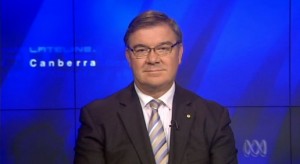
“Welcome to the solar state: We’re doubling Queensland’s use of solar energy in five years”
I’VE driven passed this Queensland Government advertising hoarding a handful of times in recent weeks. It’s on the road out of Brisbane airport and, personally, I think they (they, being the state government) should take it down.
Why? Because it’s misleading. Allow me to explain.
Firstly, Queensland might be the sunshine state, but it certainly ain’t the solar state.
According to the Queensland Renewable Energy Plan, last year only about 150 MW of the state’s 12,500 MW of installed electricity generation was coming from solar. That’s 1.2 per cent of clean, renewable energy emitting no greenhouse gases once installed.
Now the Queensland Government counts solar hot water heaters in that 150 MW. Obviously solar hot water heaters don’t generate any power at all, but they do reduce the amount of power which would have been drawn from the grid.
If you take solar hot water heaters out of the equation, the renewable energy plan says you’re left with 6MW, or 0.048 per cent of all the available power.
Now since that report was compiled, things have got a bit better or, rather, slightly less worse. Thousands of people have installed solar panels at home to take advantage of the Queensland Government’s net feed-in-tariff . Thousands more have stuck solar hot water heaters on their roof (including me), encouraged by Federal and State Government rebates.
As I’ve written a story about this issue which hasn’t yet been published, I’ll have to hold back on some of the detail for now, but I think most people would agree that Queensland is an awful long way from being in a position to declare itself a “solar state”. Perhaps if you were to get to the point where most of your energy was coming from solar, then you’d be on more solid ground.
To get an idea of how all of this looks in the bigger scheme of things, we can compare that entire state-wide 150 MW of solar energy to one single coal-fired power station. I’m going to take Tarong, which serves the southeast corner of Queensland. This single coal-fired power station has a generating capacity alone of 1400 MW and is one of the largest of more than a dozen coal-fired power stations in Queensland.
In data submitted to the Federal Government, in the year 2008/09 Tarong power station emitted 6,714,430 tonnes of greenhouse gases (bundled together and reported as CO2-equivalent). Tarong, which is owned by the Queensland Government, also has a second smaller power station known as Tarong North, which emitted a further 2,649,130 tonnes.
Now, let’s fantasise for a while that Australia introduced a tax on emissions. If you take the cheap-and-cheerful $23 per tonne suggested by The Greens as an interim price, that potentially exposes Tarong shareholders (as a state-owned corporation, that’s the State Government) to about $215 million of costs.
In one of those ironic twists that you couldn’t make up, the very next billboard on the road out of the airport is another Queensland Government effort, this time to encourage people to buy shares in QR National.
This rail hauler says proudly in its advertising that it carries “500,000 tonnes of coal a day”. If ever there was a reason not to invest in something then, for me, that would be it.
“Welcome to the coal state”
UPDATE: A pic of the QR National billboard.



 So far nowhere in the world has there been a successful trial of a technology mythically and cynically described as “clean coal” but also known by its less marketable term of Carbon Capture and Storage.
So far nowhere in the world has there been a successful trial of a technology mythically and cynically described as “clean coal” but also known by its less marketable term of Carbon Capture and Storage.



 ACCORDING to Tony Abbott, only the coalition has a credible climate change policy to achieve a five per cent cut in Australia’s emissions of greenhouse gases by 2020.
ACCORDING to Tony Abbott, only the coalition has a credible climate change policy to achieve a five per cent cut in Australia’s emissions of greenhouse gases by 2020.